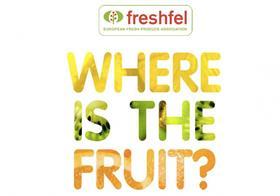
Freshfel's new study, 'Where is the fruit?', has found that the image and name of fresh fruit is still often being misused by other food sectors.
According to Freshfel, there are still too many products that are displaying fruits prominently on their packaging, despite little to no actual fruit content, confirming the main findings of a previous study in 2010.
Out of the 188 products investigated from 13 EU Member States (covering 80 per cent of the EU population), only 20 per cent had a fruit content of 50 per cent or more, while another 7 per cent of products contained no fruit at all.
To complete the figures, another 34 per cent contained less than 10 per cent of fruit and another 34 per cent contained between 11 per cent and 50 per cent of fruit.
These findings show that business practices of food operators are inconsistent with the objectives of the EU Regulation on food information to consumers, as well as the EU Regulation on nutrition and health claims, Freshfel noted.
Freshfel's study analyses the fruit content as indicated on the label of a variety of food products that use an image or a reference to fruit on the outer packaging, without targeting any particular food category or brand.
The outcome of this ‘Where is the Fruit?’ report confirms that there is still misleading information reaching the consumers. Some consumers might think they are making a healthy choice because of the use of healthy images such as fruits, whereas in reality they might be deceived and disappointed.
Freshfel pointed out that EU Regulation 1169/2011 on food information to consumers outlines that ‘food information shall not be misleading’, while EU Regulation 1924/2006 on nutrition and health claims, includes in the claim definition ‘pictures, graphic or symbolic representation, which suggests that a food has particular characteristics’. Both Regulations state that it is not allowed to make false claims, or be misleading to consumers.
Consumers need truthful information when they purchase a certain product, even more so in the current environment of increasingly health-conscious consumers and rising levels of obesity, Freshfel said.
“This ‘Where is the Fruit?’ report shows that there are still gaps in the EU legislation that can lead to consumer confusion concerning food,' said Daphne van Doorn, Freshfel’s policy advisor for sustainability and health. 'Consumers shouldn’t be misled by fruit pictures, whilst there is little to no fruit in the final product.”
According to Freshfel, one way to overcome the current situation would be to finally fully implement the nutrient profiles within the claims Regulation.
For example, for a product to be able to use the pictorial/ graphic or symbolic image of fruit, it should contain a minimum of 50g of fruit per 100g of finished product, while not exceeding maximum thresholds of salt, sugar and fat.






No comments yet